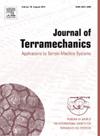Enhanced assessment framework of static stability of tracked vehicles in consideration of multi-directional loading
Abstract
Tracked vehicles are widely used in transportation, excavation, and site investigation due to their advantages of maneuverability and off-road ability. Static stability of tracked vehicles has been characterized with the static stability factor (SSF) and the static roll threshold (SRT) by assuming the ground as perfectly rigid. Considering the interaction between the vehicle and the ground, the traditional studies assess the static stability of vehicles under uni-directional loads by ignoring coupling effect between the load components. This paper enhances the traditional framework by evaluating the static stability of tracked vehicles under multi-directional loads. The two tracks of a tracked vehicle are considered as two parallel shallow foundations. The failure envelope method is adopted to capture the maximum allowable loads through swipe test and fixed ratio test. A new coefficient, factor of stability (FOS), is introduced to quantify the static stability of the tracked vehicles. Various track configurations and load combinations have been considered. The judgment process of tracked vehicle’s stability and the calculation method of FOS are detailed. The results show that the FOS obtained from the enhanced framework is more conservative than that from the traditional one.

 求助内容:
求助内容: 应助结果提醒方式:
应助结果提醒方式:


